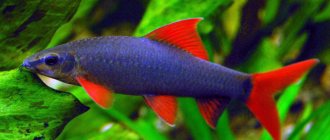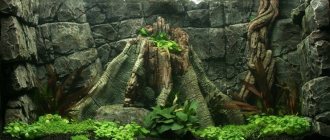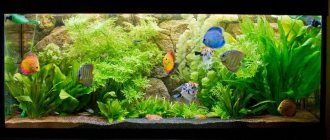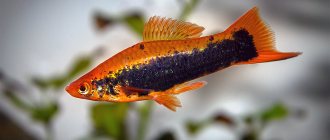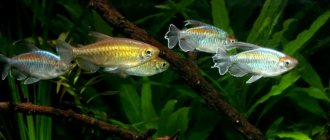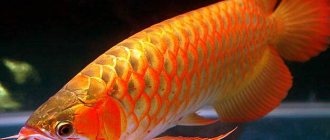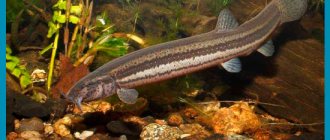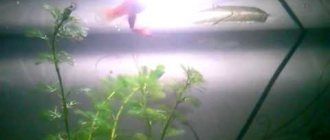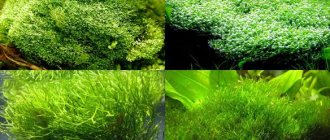Most people believe that only small ornamental fish are intended for aquarium breeding. But this is completely untrue. The opportunity to grow fairly large fish in the living conditions of a small apartment really exists. Aquariums with such marine inhabitants can bring a bit of exoticism to the interior, and also become a real hobby that brings in money. Aquarium sturgeons are excellent for such purposes. Thanks to its beautiful body shape, this fish looks very attractive in clear water. In this article we will look at the general principles of keeping sturgeon in aquariums, how to care for them and what conditions are most optimal for them.
Description of the sturgeon family
The main feature of this family, whose roots go back to prehistoric times, is the notochord. It is the backbone of the skeleton; in addition, even adults do not have a vertebral body. Sturgeons have a cartilaginous base of the skull and skeleton, the body is needle-shaped and has 5 lines of prickly spines. There are bone growths on the head, and the muzzle is cone-shaped. The dorsal fin is located close to the caudal fin. The pectoral fin has a spine, by which experts determine the age of the sturgeon. The lower part of the muzzle has 4 whiskers. In addition, this type of fish has a squirter, the same as that of shark-like representatives.
How profitable is this?
Breeding sturgeon in RAS as a business has proven itself well - if you work tirelessly and in accordance with the opinion of reason. Thus, the cost of one kilogram of products is about 600 rubles, which allows you to make a profit of up to 400 rubles. Thus, a farm that produces approximately five tons of fish per year has a turnover of about five million rubles. Of these, up to two are pure profit. Having an enterprise with a profitability level of 30-60% is quite possible. It takes only two to three years to achieve net profit and full payback of the project. Moreover, it should be taken into account that you can get not only the fish itself, but also caviar. In other words, breeding sturgeon in a RAS as a business is quite feasible. But how to implement this?
Habitat of sturgeons in the natural environment
Before you start growing sturgeon at home, you should get to know this family a little. In the natural environment, this fish is found in such reservoirs as the Volga, Yenisei, Irtysh, and Ob. In addition, representatives of sturgeon inhabit the Azov and Black Seas. Some species, such as sterlet, prefer to enter salt waters very rarely. It is this variety of sturgeon that experts recommend growing in an aquarium. If we look at the inhabitants of the Volga, then semi-anadromous sturgeons live in its waters. These fish travel to the upper delta to spawn. In their natural environment, sturgeon never migrate in large aggregations.
When the warm season ends and autumn begins, sturgeon gather in small schools for wintering. Often at this time they do not feed at all. When the ice finally melts, freshwater sturgeon rise from the bottom and go down river beds to spawn.
Lifespan
It all starts with the egg.
Having reached sexual maturity, sturgeons go to spawn. This period most often begins in spring and ends in November, with a peak in mid-summer. For reproduction, the fish chooses rivers with temperatures from +15 to +20 degrees: at higher temperatures, the eggs die.
Females spawn once every 3-5 years, males - more often. And after reproduction they do not die like other fish.
Newly born sturgeons hide under stones because they cannot swim or see well. After 10-12 days, when their body length reaches 2 cm. The fry begin to actively feed, swim well, and become similar to adults.
For the first year (in some species - 3-4 years), juveniles live in fresh water or on the border with salt water, since sea water is deadly for them.
The fish grows slowly: large species of sturgeon reach 28-35 cm at two years of age, and about 70 cm at four years of age. Only at the age of 12 do they grow to medium size.
Average lifespan of different species:
- stellate sturgeon – 30 years;
- sturgeon – 50;
- Beluga - up to 100.
The lifespan of commercial fish is affected by seasonal differences in water temperature, as well as pollution of seas, rivers and lakes.
Sturgeon at home - myth or reality?
Today, there are a huge number of different opinions regarding the keeping of representatives of this species in domestic conditions. However, most argue that the ornamental sturgeon is an aquarium fish that has good endurance, vitality and will not cause trouble to the owner. In reality, although sturgeons are unique prehistoric animals that have incredibly survived to this day, this does not add to their increased vitality, and they cannot be bred in every water. On the contrary, their requirements for purity and water quality are higher than those of other fish that can be kept in an aquarium.
Arrangement of a pond or pool
A prerequisite is the presence of water supply, sewerage, uninterrupted supply of heating and electricity. It is advisable to purchase generators. They will come in handy in case of a power outage. There are two options for sturgeon breeding:
- in ponds;
- in swimming pools.
The basement of a house is suitable for breeding fish in a pool. But the room should be quite spacious, at least 30 square meters. meters.
Pool
For a novice entrepreneur, this option will be the most suitable (and profitable). Experts call this fish breeding technology RAS, which means “installation of a closed water supply.” In practice, this is expressed in the construction of one or more connected pools with recirculation, to which water purification systems are connected.
Sturgeon breeding pools can be placed in a spacious basement
First, you will need to purchase a plastic pool (preferably round) with a depth of 1 m and a diameter of 1.5–2 m. Using one such container you can produce up to 1 ton of products per year. As production increases, new basins need to be installed. When choosing them, focus on the weight of the fish:
- for individuals weighing up to 300 g, you will need a round pool with a depth of 0.8 m and a diameter of 1.5 m;
- for fish weighing from 300 g to 2 kg - a container 1.2 in depth and 2.2 in diameter;
- for larvae weighing 0.5–5 g - rectangular plastic trays 50 cm wide and deep, 2.2 m long.
It is allowed to use pools made of materials such as:
- metal with enameled surface;
- polypropylene;
- concrete covered with ceramic tiles.
You will need to create conditions that are as close as possible to the sturgeon’s natural habitat. It will be necessary to ensure the flow of purified, oxygen-enriched water into the pool, which will be partially pumped out and fed into filters to undergo several stages of purification (mechanical, biological), equalize the temperature, saturate with oxygen and eliminate bacteria. Thus, the liquid in the RAS system must be in constant circulation.
Important! In addition to standard lighting, rooms with swimming pools should have ultraviolet lamps, which are turned on once a day to disinfect air and water.
When breeding fish in pools, the water must be well saturated with oxygen. This is done by installing a compressor.
Sturgeons also require good lighting. It should be of medium intensity. Don't use too bright a light. But you shouldn’t keep fish in a dark room either.
Video: practical tips for arranging a closed water supply installation
Natural or artificial pond
Sturgeon are bred in ponds of natural and artificial origin. This allows you to save money on purchasing equipment. If you decide to build a pond on your backyard, you should consider a number of features:
1. The place should be well lit (about 5-7 hours a day in direct sunlight).
Features of the sturgeon family
As practice shows, aquarium sturgeons kept in small containers of up to 500 liters do not grow over fifteen centimeters. But there is no need for this. Small representatives of this family have no less beauty than their large relatives. At the same time, the color of sturgeon individuals can vary from bright white to deep black. In addition, aquarium sturgeons are able to attract the eye not only with a wide range of colors, but also with increased activity, which is inherent in all representatives of this family. These fish spend most of their lives in motion.
An important point is the choice of fish species that can be in the same container with aquarium sturgeons. Since the latter are predatory representatives of the aquatic environment, smaller species of fish cannot be added to them. They will simply be eaten. Larger varieties of aquarium fish are also not suitable, since sturgeons can leave them without food.
Experts have identified species that can get along well with aquarium sturgeons and recommend adding them. These include arowana, chain catfish and armored pike. In addition, sturgeons get along well with their relatives.
Beneficial features
Sturgeon is an excellent source of easily digestible protein. Moreover, in terms of balance and “richness” of protein composition, this fish is not inferior to poultry meat. Along with this, predator meat and caviar contain biologically active components (fatty acids, vitamins and minerals) that have a positive effect on the human body.
Benefits of consuming sturgeon:
- normalizes carbohydrate metabolism;
- reduces cholesterol levels;
- increases cognitive functions of the brain;
- stimulates the activity of the immune system;
- prevents the formation of inflammatory reactions;
- improves water-salt metabolism;
- participates in the regulation of blood vessel tone;
- strengthens the myocardium;
- normalizes blood clotting processes;
- stimulates the synthesis of collagen and elastin;
- increases bone density;
- improves rheological blood parameters;
- stimulates the synthesis of enzymes, hormones and neurotransmitters;
- promotes tissue regeneration;
- slows down skin aging processes;
- increases sexual desire (libido).
However, despite its usefulness, you should not abuse sturgeon if you have diabetes, obesity and urolithiasis. In addition, to eliminate the risk of botulism infection, it is better to purchase the product from trusted suppliers.
Care and basic maintenance requirements
Keeping and caring for an aquarium sturgeon is a fairly simple process, but nevertheless requires certain knowledge. First of all, you should remember that this type of fish loves clean water with unchanged quality parameters. In order to ensure all this, you need to equip the aquarium with an aeration and filtration system that will meet all the requirements for keeping sturgeon. The best solution would be to equip an aquarium with running water, without any algae. The surface of the sturgeon's body has a large number of spines, with which they can catch algae and become entangled in them. This often ends in the death of the fish. The pointed plates cling to the plant and trap the sturgeon in it, making it impossible for them to continue swimming. As a result of this, the fish begins to twitch and fight intensely, which leads to damage to the dorsal vertebrae. Therefore, according to numerous reviews, aquarium sturgeons should be kept in containers with a bottom covered with pebbles.
Reasons for disappearance
Back in the 17th-19th centuries, up to 50 thousand tons of sturgeon were caught in the Caspian basin. At the turn of the 19th and 20th centuries, production dropped to 29 thousand tons.
In 2007, commercial fishing was prohibited in the Caspian Sea, and since 2014, the countries of this basin have agreed to end commercial sturgeon fishing.
Such stringent measures were taken to preserve the population of valuable fish.
Ichthyologists name 2 main reasons for the decline in sturgeon numbers.
- Poaching. It has grown by 30% since the early 2000s. No matter how much vandals are fined, they catch sturgeon on an almost industrial scale.
- Reduction of spawning sites due to intensive economic development in river basins.
Impurities are the sturgeon killer
The water in the aquarium must be replaced weekly. The important thing is that you do not need to change all the water, but only 20% of the total volume. Representatives of the sturgeon family cannot tolerate ammonia, nitrates and heavy organic substances. Aquarium sturgeon, the price of which is at least 200 rubles. per individual, is very capricious about the composition of the water, and impurities in it can lead to the complete extinction of the population. To prevent this from happening, before stocking the aquarium, you should find out whether the water contains substances that can harm the sturgeon.
Chemical composition
The energy value of sturgeon meat is 105 kcal, and granular caviar is 200 kcal.
Table No. 1 “Nutritional value of sturgeon meat and caviar”
| Name | Content per 100 grams of product, grams | |
| Fish fillet | Granular caviar | |
| Water | 76,55 | 56,5 |
| Squirrels | 16,14 | 28,4 |
| Fats | 4,04 | 9,3 |
| Ash | 1,1 | 5,2 |
| Cholesterol | 0,06 | 0,3 |
| Carbohydrates | 0 | 0,6 |
Table No. 2 “Vitamin and mineral composition of sturgeon meat and caviar”
| Name | Nutrient content per 100 grams of product, milligrams | |
| Fish fillet | Granular caviar | |
| Vitamins | ||
| Choline (B4) | 56 | 150 |
| Niacin (B3) | 11,32 | 9,2 |
| Pantothenic acid (B5) | 0,75 | 0,8 |
| Tocopherol (E) | 0,5 | 3,2 |
| Retinol (A) | 0,21 | 0,18 |
| Pyridoxine (B6) | 0,2 | 0,29 |
| Cholecalciferol (D) | 0,1 | 0,08 |
| Riboflavin (B2) | 0,07 | 0,36 |
| Thiamine (B1) | 0,07 | 0,3 |
| Folic acid (B9) | 0,015 | 0,024 |
| Cobalamin (B12) | 0,002 | 0,015 |
| Ascorbic acid (C) | 0 | 1,7 |
| Macronutrients | ||
| Potassium | 284 | 70 |
| Phosphorus | 211 | 460 |
| Sodium | 54 | 1620 |
| Magnesium | 35 | 35 |
| Calcium | 13 | 40 |
| Microelements | ||
| Iron | 0,7 | 2,2 |
| Zinc | 0,8 | |
| Copper | 0,04 | 0,07 |
| Manganese | 0,03 | 0,02 |
| Selenium | 0,013 | 0,04 |
Table No. 3 “Amino acid content of sturgeon”
| Name | Content of protein structures, grams |
| Glutamic acid | 2,41 |
| Aspartic acid | 1,65 |
| Lysine | 1,48 |
| Leucine | 1,31 |
| Alanin | 0,98 |
| Arginine | 0,97 |
| Valin | 0,83 |
| Glycine | 0,78 |
| Isoleucine | 0,74 |
| Threonine | 0,71 |
| Serin | 0,66 |
| Phenylalanine | 0,63 |
| Proline | 0,57 |
| Tyrosine | 0,55 |
| Methionine | 0,48 |
| Histidine | 0,48 |
| Tryptophan | 0,18 |
| Cysteine | 0,17 |
It is interesting that the protein structures of sturgeon caviar are represented mainly by complete proteins such as globulins (albumin and ichtulin). The taste of the product increases as the fish ages. The greatest value is provided by golden imperial caviar, obtained from sturgeon that have crossed the 80-year mark.
The most expensive black caviar in the world is considered to be the product of a female white sturgeon. The cost of one kilogram is 25 thousand dollars.
Water temperature
According to experts, a comfortable temperature for the life of sturgeon should be no more than 24 degrees Celsius. It is important that the temperature regime must be taken seriously, as this can negatively affect the health of the fish and lead to its death. There is an opinion that the water in the aquarium should not fall below 16 degrees, this will certainly kill the sturgeon, although in its natural environment it can feel great at lower temperatures. However, very hot water can have a detrimental effect on fish. At temperatures above 27 degrees, it stops feeding.
Cooking recipes
"Stuffed sturgeon"
Ingredients:
- sturgeon – 3 kg;
- salmon fillet – 300 g;
- cream (homemade) – 50 g;
- egg – 1 piece;
- pepper (allspice) – 5 g;
- salt (sea) – 5 g.
Recipe:
- Cut the fish. To do this, the carcass is cleaned of its entrails, and then rubbed with salt for 5 minutes. After the specified time has passed, the sturgeon is washed and blotted with a paper towel. To remove a specific odor, the fish can be rubbed with spicy spices (black pepper, thyme, parsley).
- Prepare the filling. Beat the cream and egg (separately) with a mixer, and then combine both masses. Add salt and pepper to the mixture. Grind the salmon fillet in a blender (not very finely). Combine the contents of both containers.
- Place the filling inside the prepared sturgeon carcass.
- Sew up the belly of the fish with thick threads.
- Place the stuffed sturgeon on an oiled baking sheet.
- Bake the product at 180 degrees for 60 minutes.
The finished fish is laid out on a beautiful dish and decorated with vegetable flowers, herbs and a “net” of mayonnaise.
"Sturgeon aspic"
Ingredients:
- sturgeon – 1.8 kg;
- carrots – 200 g;
- onion – 150 g;
- olives (boneless) – 100 g;
- egg – 2 pcs;
- parsley (fresh) – 1 bunch;
- gelatin – 25 g;
- allspice – 10 g;
- parsley root – 5 g;
- salt - to taste.
Cooking diagram:
- Cut up the sturgeon. To do this, remove the entrails from the fish, and then rub the carcass with salt (for 5 minutes). After this, the product is washed with water, the fillet is separated from the ridge, and the fins, tail and head are cut off.
- Pour cold water over the cuttings and put on fire. Cook for 3 minutes. Then drain the used liquid into the sink.
- Place the “recyclables” in a saucepan with fresh water and bring to a boil. After this, add carrots and onions (pre-chopped) to the broth. Simmer the mixture for 30 minutes over low heat, constantly skimming off the foam.
- Remove the head, ridge, and tail from the broth.
- Place the fish fillet back into the broth, add salt and spices. Boil until tender (15 minutes).
- Transfer the finished meat into a juicing bowl, and strain the broth through a fine sieve.
- Place chopped carrots and egg on the fish steak.
- Dilute gelatin in 100 ml of water and then pour into the fish broth. Heat this mixture to 90 degrees.
- Pour the prepared broth over the fish. Refrigerate the dish.
Jellied fish is served with horseradish, mayonnaise, olives or lemon juice.
Requirements for an aquarium with sturgeons
When choosing a container in which the sturgeon will be bred, you should take into account that there should be at least ten liters of water per 1 cm of body. Therefore, it is worth using aquariums with a volume of 250 liters or more. It is worth understanding that the size and development of fish directly depend on the size of the container in which they will live. The large size of the aquarium is also due to the fact that, due to the biological characteristics of the body, the sturgeon’s body regularly secretes mucus. He constantly has to get rid of it, and for this he needs to move regularly, and for movement he needs a large bottom area.
For optimal conditions for the existence of sturgeon in an aquarium, the water needs regular cleaning, so the tank is equipped with filtration systems with a capacity of at least 6 volumes per hour. Organizing biofiltration would also be an excellent solution. This will significantly increase the chances of success in sturgeon breeding. It is noteworthy that the sterlet is the most adapted to life in an aquarium. Therefore, experts recommend starting one.
Stellate sturgeon
Sevruga is a sturgeon that is found in Russia - the basins of the Caspian, Black, and Azov seas at a depth of one hundred to three hundred meters. Sea water is suitable for them to live, and for spawning they rise along rivers flowing into the sea. Migration continues from mid-April to June (spring) and December (winter). Males mature at 7-12 years, females at 9-15, depending on their habitat.
Description
The body of the stellate sturgeon is covered with scutes that fit tightly to each other. The forehead is convex, 4 smooth antennae do not reach the mouth, the lower lip is not sufficiently developed.
The peculiarity of the sturgeon is its long, elongated body and nose, which looks like a dagger.
The color is brown with a bluish tint, and there is a white stripe on the belly.
The weight of sevruga is about 10 kg, the length is about 1 meter. Maximum age is 35 years.
Keeping sturgeon in aquariums: what to feed
Growing sturgeon in an aquarium is a fairly simple task if you follow a number of rules. Particular attention should be paid to nutrition. Feed is, first of all, a factor that directly affects the health and development of fish. When selecting food for sturgeon, you should take into account that it feeds from the bottom, which means that food should only be used that can sink in the water, and not float on the surface of the water. In addition, you need to understand that representatives of the sturgeon family have a sensitive sense of smell. When choosing food, you should pay attention to whether its smell is pleasant to the fish.
Another important factor is its structure. The feed should be well compressed and not destroyed by water. Pelleted food is best. This type must be chosen in view of the sturgeon’s nutritional characteristics. The fish does not swallow food whole, but does it gradually, so the food must remain in its original state for at least half an hour. It is noteworthy that although food for sturgeon should not be destroyed for a long time by exposure to water, it should not be hard. This fish is only suitable for soft food, which it can eat faster. If the goal is to grow a large individual from a small sturgeon, then you need to understand that in this case the food must also have a large amount of calories.
The size of the feed is also important. If it is purchased for fry, then its pieces should be small. Today, there are many types of food for sturgeon bred in aquariums and pools, but experts recommend using those types that contain phosphorus, lysine, protein and fiber. This set of microelements will have a beneficial effect on the fish’s body.
Author:
External characteristics
Aquarium sturgeon come in different sizes. Its development depends solely on its habitat. From a visual point of view, the head has a triangular shape, it is extended forward and has certain protective shields. As for the muzzle, it has a conical shape, with fringed antennae located in its lower part.
Characteristics of sturgeon
If we take the general dimensions of the sturgeon’s head, then half of this part of the body is allocated for the muzzle. The oral cavity is located below. It has a transverse shape; if you pay attention to the lower lip, it is interrupted.
In most cases, the sturgeon family has an elongated shape that resembles a spindle. If we determine sexual characteristics, then aquarium sturgeons (female or male) do not stand out much. It is worth noting that sterlet can interbreed with other species of sturgeon.
If we compare the size of sturgeon in natural spaces and in an aquarium, then wild fish have dimensions of 120–150 cm, with a weight of 2 to 20 kg. Regarding aquarium specimens, we can say that their size is 10–18 cm, their weight is about 30–100 g. In aquarium mode, growth occurs rather slowly.
Purchasing fish
First you need to acquire livestock. Fry are used for breeding. Their acquisition is the first stage of activity. First of all, you should get at least ten thousand fry. Why so much? The fact is that even with experienced specialists, their death rate reaches about 60% of the total. It is possible to reduce this value, but this is a difficult and costly matter. Fortunately, their cost is about 20 rubles per piece, and their weight is several grams. Therefore, there should be no problems with their acquisition and transportation.
By the way, it’s better not to skimp on your first fish. Of course, even if you buy dried fry and provide them with good conditions, they will recover over time. But time will be lost, more funds will be required for their maintenance, and we should not forget about the case. Therefore, it is better not to skimp on quality.
How to grow fish?
Many years of experience and experimentation have allowed us to select several optimal methods. Two of them are described below:
- Kiselev's technique. It involves stocking the pools with fish twice a year. It also involves harvesting once every six months. The disadvantage of this technique is that it is difficult to gain a lot of weight over such a significant period.
- Krasnoborodko's technique. Provides such an approach to fish breeding, when the crop is harvested at short intervals, but in small quantities. This system allows for uninterrupted operation thanks to numerous water purification filters, water disinfection devices, pumps and periodic fluid renewal. This technique involves exclusively one-time stocking of pools with fish. It allows you to minimize the area required for breeding in terms of placement of equipment, as well as the number of pools.
